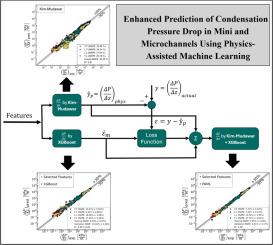利用物理辅助机器学习增强迷你和微通道冷凝压降的预测
IF 5.8
2区 工程技术
Q1 ENGINEERING, MECHANICAL
International Journal of Heat and Mass Transfer
Pub Date : 2025-09-25
DOI:10.1016/j.ijheatmasstransfer.2025.127838
引用次数: 0
摘要
在微型和微通道冷凝过程中摩擦压降的可靠预测支持热管理有效性和紧凑的两相热交换器,冷板和芯片上的冷却回路的整体传热性能。压力损失过大会增加泵的负担,增加电力消耗,并可能导致流量不稳定,而预测不足则有温度超调和过早干化的风险。一旦通道大小、工作流体或操作条件超出其测试范围,传统的经验相关性和灵活的机器学习模型就会失去准确性。本研究使用了物理辅助机器学习框架,该框架将XGBoost残差学习器覆盖在Kim-Mudawar分离流相关上,以实现高保真度和稳健性的压降预测。一个由6566个凝结数据点(40个研究;0.07≤Dh≤6.22 mm; 32.7≤G≤1926 kg m(⁻²s⁻¹;22种液体)组成的精心策划的数据库被组装起来。评估了四种特征集(物理、无量纲、统计选择、完整),贝叶斯超参数优化与五倍交叉验证以及流体和质量速度保留相结合,量化了插值和外推。在整个数据集中,物理辅助机器学习将平均绝对百分比误差从Kim-Mudawar的24%和纯机器学习的9.5 - 10.3%降低到7.4 - 8.3%,达到R²>; 0.985。对于基准制冷剂R134a,插值平均绝对百分比误差从22% (Kim-Mudawar)下降到约14%。对于介电流体HFE7000/HFE7100(训练期间未见),外推误差从纯机器学习的150%下降到约40%。质量-速度偏差在高质量速度条件下误差≤15%,在最具挑战性的低质量速度条件下误差≤42%。这些进步使泵尺寸、歧管设计和热阻预算更加可靠,直接支持电子产品、电动汽车和航空航天平台的节能、高热通量热管理硬件的开发。本文章由计算机程序翻译,如有差异,请以英文原文为准。

Enhanced prediction of condensation pressure drop in mini and microchannels using physics-assisted machine learning
Reliable prediction of frictional pressure drop during condensation in mini‑ and microchannels underpins both thermal management effectiveness and overall heat transfer performance in compact two‑phase heat exchangers, cold‑plates, and on‑chip cooling loops. Excess pressure loss burdens pumps, raises electrical consumption, and can destabilize flow, whereas under‑prediction risks temperature overshoot and premature dryout. Conventional empirical correlations and flexible machine-learning models can lose accuracy once channel size, working fluid, or operating conditions stray beyond their testing range. This study uses a physics‑assisted machine‑learning framework that overlays an XGBoost residual learner on the Kim–Mudawar separated‑flow correlation to achieve high fidelity and robustness in pressure drop prediction. A curated database of 6566 condensation data points (40 studies; 0.07 ≤ Dh ≤ 6.22 mm; 32.7 ≤ G ≤ 1926 kg m⁻² s⁻¹; 22 fluids) was assembled. Four feature sets (physical, dimensionless, statistically selected, full) were evaluated, and Bayesian hyper‑parameter optimization combined with five‑fold cross‑validation plus fluid‑ and mass‑velocity holdouts quantified both interpolation and extrapolation. Across the full dataset, physics‑assisted machine‑learning lowered the mean absolute percentage error from 24 % with Kim–Mudawar and 9.5–10.3 % with pure machine learning to 7.4–8.3 %, achieving R² > 0.985. For the benchmark refrigerant R134a, interpolation mean absolute percentage error dropped from 22 % (Kim–Mudawar) to ≈14 %. For dielectric fluids HFE7000/HFE7100 (unseen during training) extrapolation error fell from >150 % with pure machine learning to ≈40 %. Mass‑velocity holdouts confirmed ≤15 % error at high mass velocity and ≤42 % at the most challenging low mass velocity conditions. These advances enable more reliable pump sizing, manifold design, and thermal‑resistance budgeting, directly supporting the development of energy‑efficient, high‑heat‑flux thermal management hardware for electronics, electrified vehicles, and aerospace platforms.
求助全文
通过发布文献求助,成功后即可免费获取论文全文。
去求助
来源期刊
CiteScore
10.30
自引率
13.50%
发文量
1319
审稿时长
41 days
期刊介绍:
International Journal of Heat and Mass Transfer is the vehicle for the exchange of basic ideas in heat and mass transfer between research workers and engineers throughout the world. It focuses on both analytical and experimental research, with an emphasis on contributions which increase the basic understanding of transfer processes and their application to engineering problems.
Topics include:
-New methods of measuring and/or correlating transport-property data
-Energy engineering
-Environmental applications of heat and/or mass transfer

 求助内容:
求助内容: 应助结果提醒方式:
应助结果提醒方式:


